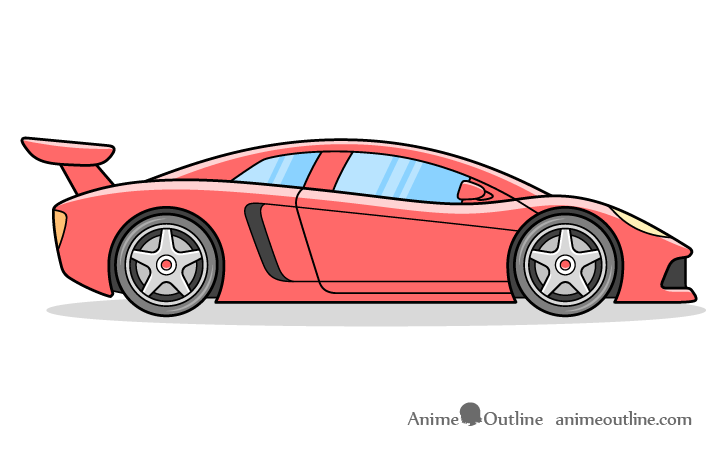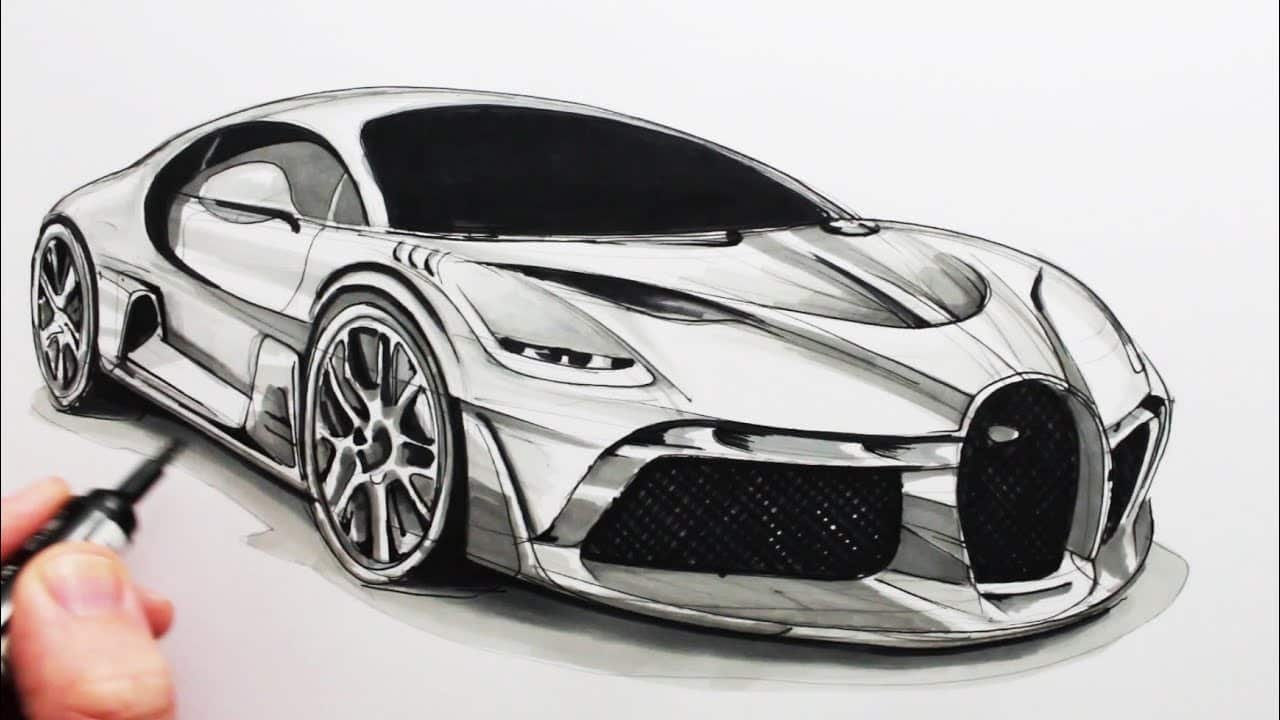Drawing a sports car can be both exciting and challenging. It’s a great way to express creativity and improve drawing skills.
Sports cars have unique shapes and sleek designs that make them interesting subjects for artists. Whether you are a beginner or an experienced artist, capturing the essence of a sports car requires attention to detail. From the aerodynamic curves to the intricate details of the wheels, each element plays a part in creating a realistic drawing.
This blog post will guide you through the process, providing tips and techniques to help you draw a stunning sports car. Grab your pencils and let’s get started on this artistic journey!
Introduction To Sport Car Drawing
Sport car drawing is an exciting and rewarding hobby. It helps you understand the sleek lines and dynamic forms of these high-performance vehicles. Whether you are a beginner or a seasoned artist, drawing sport cars can enhance your creative skills and attention to detail.
Importance Of Precision
Precision is crucial in sport car drawing. These cars have unique designs that set them apart. Accurate lines and proportions are essential to capture their essence. Mistakes in the drawing can make the car look unrealistic. Ensure your drawings reflect the speed and power of the sport car.
To improve precision:
- Use reference images of real sport cars.
- Start with basic shapes and gradually add details.
- Measure proportions carefully.
- Practice regularly to refine your skills.
Tools And Materials Needed
Having the right tools and materials can make a significant difference in your drawing quality. Here are some essentials:
| Tool/Material | Description |
|---|---|
| Pencils | Use different grades for shading and detailing. |
| Erasers | Needed for correcting mistakes and refining lines. |
| Paper | Choose smooth paper for better pencil control. |
| Ruler | Helps in drawing straight lines and accurate measurements. |
| Blending stumps | Useful for smooth shading and transitions. |
With these tools, you can achieve clean lines, precise details, and realistic shading in your sport car drawings.

Credit: www.freepik.com
Choosing The Right Car Model
Drawing a sports car involves selecting the right model to capture speed and elegance. Focus on sleek lines and dynamic shapes.
Choosing the right car model is crucial for sport car drawing. The car you select will influence your drawing’s complexity and detail. It’s important to pick a model that excites you. This will keep you motivated throughout the drawing process.
Popular Sport Car Models
Many artists love drawing popular sport car models. These include the Ferrari, Lamborghini, and Porsche. These cars have sleek lines and powerful shapes. They are also easily recognizable. This makes them fun and rewarding to draw. Another favorite is the Ford Mustang. It has a muscular look with bold features. The Corvette is also a great choice. It combines elegance with speed. Each car has its unique appeal.
Considering Car Features
When choosing a car model, consider its features. Look at the car’s body shape. Notice the curves and angles. These details add character to your drawing. Examine the car’s wheels and rims. They often have intricate designs. Pay attention to the headlights and taillights. These can be tricky but rewarding to draw. Think about the car’s interior. Although not always visible, it adds depth to your work. The seats, steering wheel, and dashboard can make your drawing more detailed. Choose a model that challenges you. This will improve your skills and make your drawing stand out. “`
Basic Sketching Techniques
Basic sketching techniques are crucial for creating impressive sport car drawings. These techniques help you build a solid foundation and capture the essence of a sport car. In this section, we will cover two primary aspects: outlining the car shape and adding basic details. Let’s dive in!
Outline The Car Shape
Start by drawing a simple rectangle. This will be the car’s body. Then, sketch a smaller rectangle on top for the roof. Use light, quick strokes to make adjustments easy. Next, draw two circles at the bottom for the wheels. Ensure they are evenly spaced. Connect the wheels with curved lines to form the fenders. Finally, draw the windshield and side windows within the roof rectangle.
Adding Basic Details
Begin by refining the car’s shape. Smooth out the lines and define the body contours. Add the headlights and taillights at the front and back. Draw the grill and bumper, giving the front a more detailed look. Next, add side mirrors and door handles to the car’s sides. Outline the wheels with more definition, adding rims and tire treads. Sketch the car’s interior through the windows, indicating seats and the steering wheel.
With these basic sketching techniques, you can create a solid foundation for your sport car drawing. Practice these steps to improve your skills and produce stunning car sketches.
Mastering Proportions
Creating a stunning sport car drawing requires more than just talent. Mastering proportions is key to achieving a realistic and dynamic look. Getting the car dimensions right ensures your drawing stands out. Let’s explore how to master this essential skill.
Understanding Car Dimensions
Understanding car dimensions is crucial in sport car drawing. Start by studying real cars. Observe their length, width, and height. Note how these dimensions relate to each other. This helps in maintaining the right proportions.
Use reference images of sport cars. Look at the side, front, and top views. This gives a comprehensive understanding of the car’s structure. Sketch simple shapes to represent the car’s main parts. Focus on the overall form first. Details come later.
Maintaining Accuracy
Accuracy is vital in sport car drawing. Begin with a light sketch. Use a ruler if needed. Ensure the lines are straight and proportions are correct. Compare your sketch with reference images. Make adjustments as needed. This ensures your drawing stays accurate.
Check the proportions regularly. Measure different parts of the car. Ensure they match the reference images. Pay attention to the wheels, windows, and headlights. These elements must be in the right place. They add to the car’s realism.
Practice regularly. The more you draw, the better you get. Over time, you’ll develop an eye for accurate proportions. Your sport car drawings will improve significantly.
Adding Depth And Perspective
Enhance your sport car drawing by adding depth and perspective. Use shading and vanishing points to create a realistic look. Keep lines precise and angles accurate for a more dynamic effect.
Adding depth and perspective to your sport car drawing can transform it from a flat image into a lifelike representation. This section will guide you through the essential techniques. These techniques will help you create a more dynamic and engaging drawing.
Creating A 3d Effect
To make your sport car appear three-dimensional, focus on shading. Shadows and highlights add depth. Observe where the light source hits the car. Highlight these areas using lighter shades. Darken the areas that are farther from the light source. This contrast will give your car a realistic, 3D look. Another technique involves contour lines. Draw lines following the shape of the car. These lines help show the curves and angles. They guide the viewer’s eyes along the car’s body, enhancing the 3D effect.
Using Vanishing Points
Vanishing points are crucial for achieving perspective in your drawing. Start by choosing a horizon line. This line represents the viewer’s eye level. Place one or two vanishing points on this line. Lines drawn from the car should converge at these points. This creates the illusion of depth. It makes the car appear as if it’s receding into the distance. Experiment with different positions for your vanishing points. This can change the perspective dramatically. Practice is key to mastering this technique. By focusing on these methods, your sport car drawing will gain depth and perspective. Your artwork will stand out, capturing the viewer’s attention.
Detailing The Exterior
Detailing the exterior of a sports car drawing is crucial for capturing its essence. Each component, from the headlights to the wheels, adds to the car’s sleek appearance. Let’s dive into the specifics.
Drawing Headlights And Taillights
The headlights and taillights are the eyes and the signature of the car. Start by sketching the shape of the headlights. They are often sleek and narrow for sports cars.
Use light, curved lines to outline them. Add circles or ovals within for the bulbs. Pay attention to the details inside, like reflectors and small lights.
For the taillights, repeat a similar process. Tail lights are usually more rectangular. Add lines and shapes inside to show the different sections for brake lights and indicators.
Rendering Wheels And Tires
The wheels and tires make a significant impact on the car’s stance. Begin by drawing a circle for the tire. Ensure it’s proportionate to the car’s body.
- Rims: Draw the inner circle for the rim. Add spokes radiating from the center. The number of spokes can vary, but five or six is common.
- Tires: Add tread patterns on the tires for realism. Simple zigzags or crosshatch patterns work well.
Position the wheels correctly in the wheel arches. The front wheels might be slightly turned to add dynamism.
Use these steps to ensure your sports car drawing looks realistic and dynamic. Attention to detail in these areas will make your drawing stand out.
Enhancing With Shading
Enhancing your sport car drawing with shading can bring it to life. This technique adds depth, realism, and a three-dimensional feel. Shading helps to create realistic shadows and highlights reflective surfaces. Let’s explore some key techniques to achieve this.
Techniques For Realistic Shadows
Shadows give your drawing a sense of space and volume. Use a light source reference. Determine where the light hits the car. The areas opposite will be in shadow. Gradually build up the darkness. Start light and increase pressure for darker areas. Use blending tools like stumps or your finger. This creates smooth transitions.
Highlighting Reflective Surfaces
Sport cars often have glossy, reflective surfaces. Capturing this can enhance realism. Identify the brightest spots where light reflects. Leave these areas mostly white. Use a sharp pencil for crisp edges. Blend softly around these highlights. This contrast creates the illusion of shine. Reflective surfaces also show the environment. Add subtle hints of surrounding colors. This adds an extra layer of realism.

Credit: www.animeoutline.com
Final Touches And Refinements
Final touches and refinements bring your sport car drawing to life. They add depth, detail, and a polished look. This step separates a good drawing from a great one. Focus on these last details to make your art stand out.
Polishing Your Drawing
Start by enhancing the lines. Make sure they are clean and crisp. Use a fine-tipped pen for sharp edges. This gives your drawing a professional finish.
Add more details to the car’s body. Think about lights, grills, and mirrors. Small elements make the car look realistic. Draw shadows to give the car depth. Lightly shade areas to create a 3D effect.
Consider the car’s surface. Add reflections to windows and body panels. This makes the car look shiny and new. Use white or light grey for highlights.
Reviewing And Correcting Mistakes
Take a step back and look at your drawing. Check for any obvious errors. Correct any lines that look out of place. Make sure proportions are accurate.
Erase any stray marks. Clean up your workspace. This ensures your drawing looks neat. Pay attention to the wheels. They should be round and symmetrical.
Ask for feedback from others. Fresh eyes can spot mistakes you missed. Make necessary adjustments based on their input.

Credit: www.youtube.com
Frequently Asked Questions
How To Start Drawing A Sports Car?
Begin by sketching the basic outline of the car. Focus on the body shape and proportions.
What Tools Do I Need?
You need pencils, erasers, and drawing paper. Optional tools include rulers and colored pencils.
How To Draw Car Wheels?
Draw two circles for each wheel. Add details like rims and tires for a realistic look.
How To Add Details To A Sports Car?
Add headlights, grills, and mirrors. Focus on capturing the car’s unique features and details.
Conclusion
Drawing sport cars can be fun and rewarding. Practice improves your skills. Use simple shapes to start. Observe real cars for details. Experiment with different styles. Keep your drawings clean and sharp. Share your work with friends. They can offer helpful feedback.
Stay patient and enjoy the process. Happy drawing!



